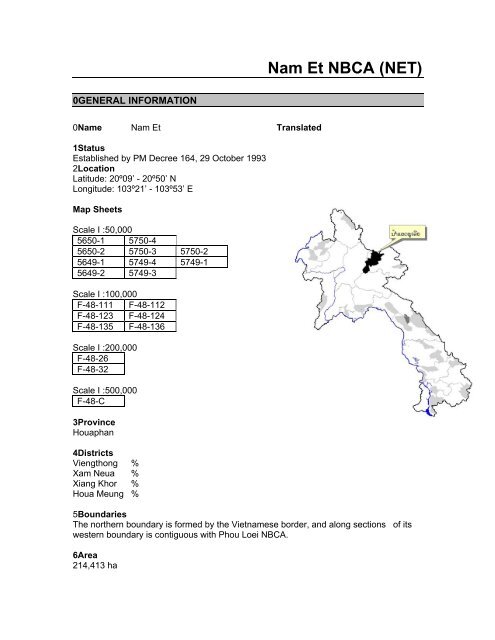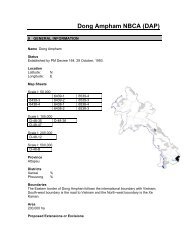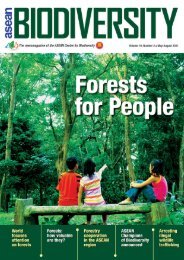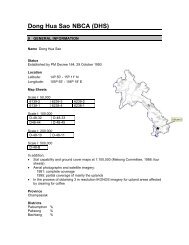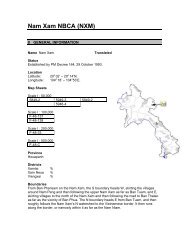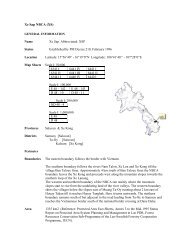Nam Et NBCA (NET)
Nam Et NBCA (NET)
Nam Et NBCA (NET)
You also want an ePaper? Increase the reach of your titles
YUMPU automatically turns print PDFs into web optimized ePapers that Google loves.
<strong>Nam</strong> <strong>Et</strong> <strong>NBCA</strong> (<strong>NET</strong>)<br />
0GENERAL INFORMATION<br />
0<strong>Nam</strong>e <strong>Nam</strong> <strong>Et</strong> Translated<br />
1Status<br />
Established by PM Decree 164, 29 October 1993<br />
2Location<br />
Latitude: 20º09’ - 20º50’ N<br />
Longitude: 103º21’ - 103º53’ E<br />
Map Sheets<br />
Scale I :50,000<br />
5650-1 5750-4<br />
5650-2 5750-3 5750-2<br />
5649-1 5749-4 5749-1<br />
5649-2 5749-3<br />
Scale I :100,000<br />
F-48-111 F-48-112<br />
F-48-123 F-48-124<br />
F-48-135 F-48-136<br />
Scale I :200,000<br />
F-48-26<br />
F-48-32<br />
Scale I :500,000<br />
F-48-C<br />
3Province<br />
Houaphan<br />
4Districts<br />
Viengthong %<br />
Xam Neua %<br />
Xiang Khor %<br />
Houa Meung %<br />
5Boundaries<br />
The northern boundary is formed by the Vietnamese border, and along sections of its<br />
western boundary is contiguous with Phou Loei <strong>NBCA</strong>.<br />
6Area<br />
214,413 ha
(in combination with Phou Loei <strong>NBCA</strong>, directly adjacent to the western boundary: 3880<br />
km²)<br />
7Proposed Extensions or Excisions<br />
Based on vegetation cover maps, <strong>Nam</strong> <strong>Et</strong> should be reduced in size by excising some<br />
500 km² mainly in the east and the Vietnam border regions.<br />
8Reasons for Proposed Extensions or Excisions<br />
9Access<br />
Xop Neua, a centrally located district centre, can be reached by 4WD-vehicle on a rarely<br />
used seasonal road from Sam Neua (112 km) and on an all-weather road from Muang<br />
Hiam (65 km).<br />
10Stakeholder Villages and Population<br />
District No. of Villages No. of Villages by type Population<br />
I II III IV<br />
TOTAL<br />
Note: Only small villages within the <strong>NBCA</strong>.<br />
11Principal Local Resource Uses<br />
The predominant land use is shifting-cultivation<br />
12<strong>Et</strong>hnic Composition<br />
2 BRIEF HISTORY<br />
1993 <strong>NBCA</strong> declared<br />
3 ECOLOGY<br />
13Physical Features<br />
The entire area is comprised of rugged hills usually well above 1,000 m (65%) with the<br />
highest peak at 2,052 m. Most streams drain to the <strong>Nam</strong> <strong>Et</strong>, the remainder to the <strong>Nam</strong><br />
Peun.<br />
14Elevation<br />
500 – 2052 m<br />
15Climate
16Main Forest Types<br />
The forested area is about 72% with:<br />
Dense/mature forest 10%<br />
Mixed deciduous forest 69%<br />
Evergreen forest 3%<br />
Other natural vegetation 19%<br />
17Other Habitat Features<br />
The vegetation is generally a mosaic of old shifting cultivation fallow, bamboo groves.<br />
18Recorded Vertebrates 1<br />
19MAMMALS<br />
Common <strong>Nam</strong>e Scientific <strong>Nam</strong>e National<br />
Priority<br />
Global<br />
Threat<br />
Category<br />
Lao Risk<br />
Status<br />
Bear Macaque Macaca arctoides - VU PARL<br />
White-cheeked Crested Hylobates leucogenys HNP DD PARL<br />
Gibbon<br />
Yellow-cheeked Crested Hylobates Gabriellae INP DD LKL<br />
Gibbon<br />
Bear species Species not identified - - -<br />
Otter species Species not identified - - -<br />
Tiger Panthera tigris ANP EN ARL<br />
Asian Elephant Elephas Maximus HNP EN ARL<br />
Pig species Species not identified - - -<br />
Sambar Cervus unicolor - 0 PARL<br />
Southern serow Naemorhedus sumatraensis - VU PARL<br />
Inornate Squirrel Callosciurus inornatus - VU LKL<br />
East Asian Porcupine Hystrix Brachyura - VU 0<br />
20BIRDS<br />
No birds present of Acute, High or Indeterminate National Priority<br />
Common <strong>Nam</strong>e Scientific <strong>Nam</strong>e National<br />
Priority<br />
Global<br />
Threat<br />
Category<br />
Lao Risk<br />
Status<br />
Blyth’s Kingfisher Alcedo hercules - VU PARL<br />
Spot-bellied Eagle Owl Bubo nipalensis - GNT PARL<br />
Blue-naped Pitta Pitta nipalensis - GNT LKL<br />
Jerdon’s Bushchat Saxicola jerdoni - GNT 0<br />
Grey Laughingthrush Garrulax maesi - GNT 0<br />
Rufous-vented<br />
Garrulax gularis - 0 LKL<br />
Laughingthrush<br />
Spotted Wren Babbler Spelaeornis formosus - GNT 0<br />
Rufous-throated Fulvetta Alcippe rufogularis - GNT 0<br />
CLASSIFICATION KEY (from Duckworth et al., 1999)<br />
1 See priority/ threat/ risk classification key at the end of this section.
National Priority Categories<br />
ANP: Acute National Priority; HNP: High National Priority; INP: Intermediate National Priority<br />
Global Threat Categories<br />
0: not listed as of concern; DD: data deficient; GNT: globally near-threatened; GT-CR: globally threatened -<br />
critical; GT-EN: globally threatened - endangered; GT-VU: globally threatened - vulnerable; n/a: not<br />
applicable.<br />
Lao Risk Status<br />
0: not at risk in Lao PDR; ARL: at risk in Lao PDR; CARL: conditionally at risk in Lao PDR; LKL: little known<br />
in Lao PDR; n/a: not applicable; PARL: potentially at risk in Lao PDR.<br />
4 PRINCIPAL CONTRIBUTIONS TO THE <strong>NBCA</strong> SYSTEM<br />
Biodiversity Values<br />
The flora and fauna have not been fully surveyed<br />
<strong>Nam</strong> <strong>Et</strong> has comparatively little dense forest but still ranks high in its importance for<br />
representative coverage mainly due to its size in a geographical sub-unit where few<br />
other <strong>NBCA</strong>s have been identified.<br />
The <strong>Nam</strong> <strong>Et</strong> and its tributaries are reportedly teeming with fish even close to long<br />
existing villages.<br />
Watershed Values<br />
Cultural Values<br />
Recreation & Tourism Values<br />
Principal Threats<br />
• Shifting cultivation<br />
5 CURRENT MANAGEMENT<br />
Contact<br />
Staffing<br />
Management Structure<br />
An <strong>NBCA</strong> ‘team’, made up of mixed PAFO and DAFO staff, has its own plans, budgets<br />
and activities – though these must still pass though the PFO and PAFO. Staff are<br />
divided into functional specialisation units according to the key management themes,<br />
and are based in a field headquarters or at field stations in the <strong>NBCA</strong>.
Buildings<br />
Financial Support & Training<br />
Currently no full-time donor support<br />
Current Management Priorities<br />
• Establishment of settlement control<br />
• Reduction of severe shifting cultivation practices in some areas<br />
• Re-Examination of boundaries<br />
• In-depth biophysical and social surveys<br />
21Other Projects Active in the Area<br />
• Lao-American Drug Control Project<br />
6 REPORTS AND PUBLICATIONS<br />
1<br />
2<br />
3<br />
4<br />
Anon. (1993). Reconnaissance Survey Report.<br />
IUCN (1995). Protected Area Fact-Sheets. Annex 3 to the mid-1995 status report on<br />
Protected Area system planning and management in Lao PDR. Vientiane.<br />
IUCN (1998). Biodiversity Conservation and Integrated Community Development in<br />
<strong>Nam</strong> <strong>Et</strong> and Phou Loei <strong>NBCA</strong>s, Lao PDR. 3 rd revision of project proposal: 30 pp.<br />
Vientiane.<br />
Wildlife Conservation Society (1995). Report on Management Options<br />
Reconnaissance.


